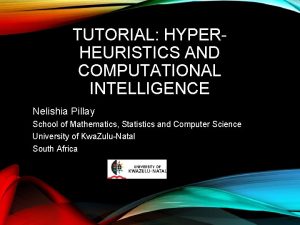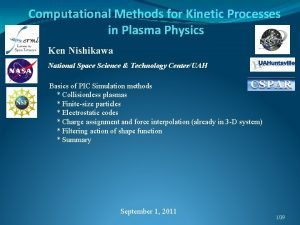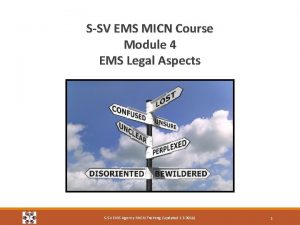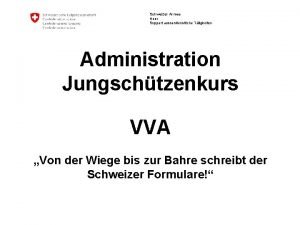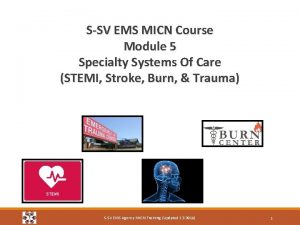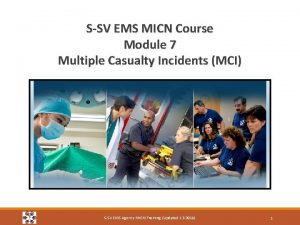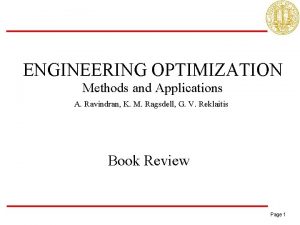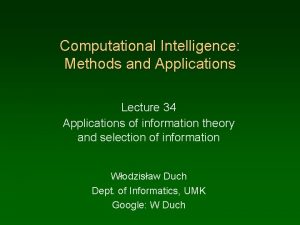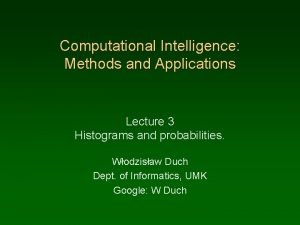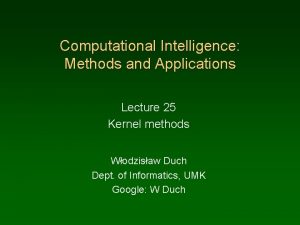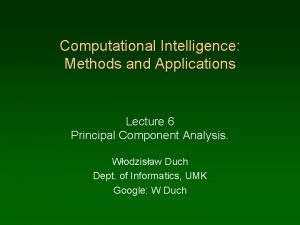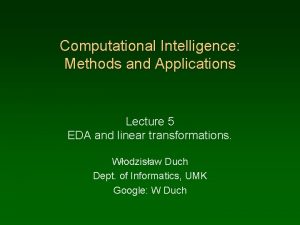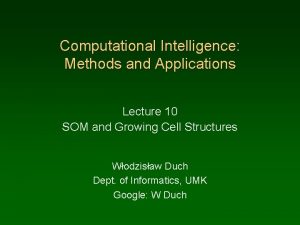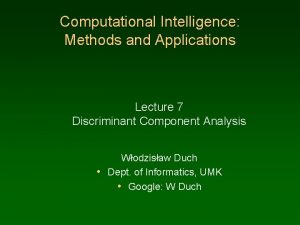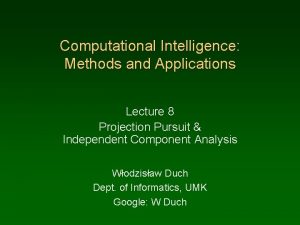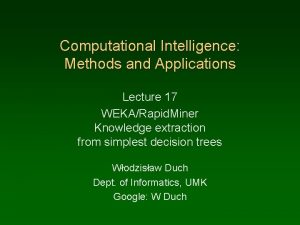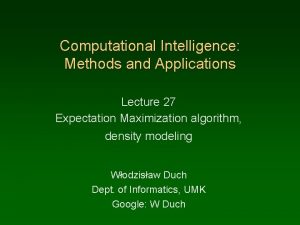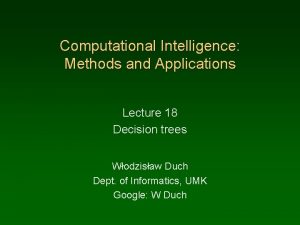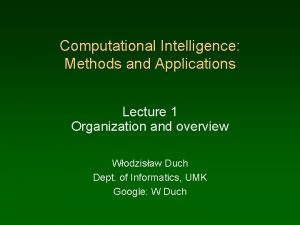Computational Intelligence Methods and Applications Lecture 20 SSV














- Slides: 14

Computational Intelligence: Methods and Applications Lecture 20 SSV & other trees Włodzisław Duch Dept. of Informatics, UMK Google: W Duch

Ghost. Miner Philosophy Ghost. Miner, data mining tools from our lab. http: //www. fqspl. com. pl/ghostminer/ or write “Ghostminer” in Google. • Separate the process of model building and knowledge discovery from model use => Ghost. Miner Developer & Ghost. Miner Analyzer. • There is no free lunch – provide different type of tools for knowledge discovery. Decision tree, neural, neurofuzzy, similarity-based, committees. • Provide tools for visualization of data. • Support the process of knowledge discovery/model building and evaluating, organizing it into projects.

SSV in GM SSV = Separability Split Value, simple criterion measuring how many pairs of samples from different classes are correctly separated. Define subsets of data D using a binary test left and right subset D = LS RS. f(X, s) to split the data into Tests: defined on vector X, usually on a single attribute Xi for continuous values comparing it with a threshold s, f(X, s) = T Xi < s or a subset of values for discrete attributes. Another type of tests giving quite different shapes of decision borders is based on distances from prototypes.

SSV criterion Separability = the number of samples that are in LS subset and are from class wc times the number of elements in RS from all the remaining classes, summed over all classes. If several tests/thresholds separate the same number of pairs (this may happen for discrete attributes) select the one that separates a lower number of pairs from the same class. SSV is maximized; first part should dominate, hence factor 2. Simple to compute, creates full tree using top-down algorithm with bestfirst search or beam search procedures to find better trees. Uses cross-validation training to select nodes for backward pruning.

SSV parameters Generalization strategy: defines how the pruning is done. First, try to find optimal parameters for pruning: final number of leaf nodes, or pruning degree k = remove all nodes that increased accuracy by k samples only. Given pruning degree or given nodes count define these parameters by hand. “Optimal” uses cross-validation training to determine these parameters: the number of CV folds and their type has to be selected. Optimal numbers: minimize sum of errors in the test parts of CV training. Search strategy: use the nodes of tree created so far and: use the best-first search, i. e. select the next node for splitting; use beam search: keep ~10 best trees, expand them; avoids local maxima of the SSV criterion function but rarely gives better results.

SSV example Hypothyroid disease, screening data with 3772 training (first year) and 3428 test (second year) examples, majority 92. 5% are normal, the rest are primary hypothyroid or compensated hypothyroid cases. TT 4 attribute: red is # errors; green - # correctly separated pairs; blue is # pairs separated from the same class (here always zero).

Wine data example Chemical analysis of wine from grapes grown in the same region in Italy, but derived from three different cultivars. Task: recognize the source of wine sample. 13 quantities measured, continuous features: • alcohol content • ash content • magnesium content • flavanoids content proanthocyanins phenols • content • • OD 280/D 315 of diluted wines • • • Wine robot malic acid content alkalinity of ash total phenols content nonanthocyanins phenols content color intensity hue • proline.

C 4. 5 tree for Wine J 48 pruned tree: using reduced error (3 x crossvalidation) pruning: ---------OD 280/D 315 <= 2. 15 | alkalinity <= 18. 1: 2 (5. 0/1. 0) | alkalinity > 18. 1: 3 (31. 0/1. 0) OD 280/D 315 > 2. 15 | proline <= 750: 2 (43. 0/2. 0) | proline > 750: 1 (40. 0/2. 0) Number of Leaves : 4 Size of the tree : 7 Correctly Classified Instances Incorrectly Classified Instances Total Number of Instances 161 17 178 90. 44 % 9. 55 %

WEKA/RM output WEKA output contains confusion matrix, RM has transposed matrix a b c <= classified as 56 3 0 | a = 1 (class number) 4 65 2 | b = 2 3 1 44 | c = 3 2 x 2 matrix: WEKA: TP Rate 0. 949 0. 915 0. 917 TP FP P+(M) FN TN P-(M) P+ P 1 P(true|predicted) Pr=Precision=TP/(TP+FP) R =Recall = TP/(TP+FN) F-Measure = 2 Pr*R/(P+R) FP Rate Precision Recall F-Measure Class 0. 059 0. 889 0. 949 0. 918 1 0. 037 0. 942 0. 915 0. 929 2 0. 015 0. 957 0. 917 0. 936 3

WEKA/RM output info Other output information: Kappa statistic 0. 8891 (corrects for chance agreement) Mean absolute error 0. 0628 Root mean squared error 0. 2206 Root relative squared error Relative absolute error 47. 0883% 14. 2992%

Simplest SSV rules Decision trees provide rules of different complexity, depending on the pruning parameters. Simpler trees make more errors but help to understand data better. In SSV pruning degree or pruning nodes may be selected by hand. Start from small number of nodes, see how the number of errors in CV will change. Simplest tree: 5 nodes, corresponding to 3 rules; 25 errors, mostly Class 2/3 wines mixed.

Wine – SSV 5 rules Lower pruning leads to more complex but more accurate tree. 7 nodes, corresponding to 5 rules; 10 errors, mostly Class 2/3 wines mixed. Try to lower the pruning degree or increase the node number and observe the influence on the error. av. 3 nodes train 10 x: 87, 0± 2, 1% test 80, 6± 5, 4± 2, 1% av. 7 nodes train 10 x: 98, 1± 1, 0% test 92, 1± 4, 9± 2, 0% av. 13 nodes train 10 x: 99, 7± 0, 4% test 90, 6± 5, 1± 1, 6%

Wine – SSV optimal rules What is the optimal complexity of rules? Use crossvalidation to estimate optimal pruning for best generalization. Various solutions may be found, depending on the search parameters: 5 rules with 12 premises, making 6 errors, 6 rules with 16 premises and 3 errors, 8 rules, 25 premises, and 1 error. if OD 280/D 315 > 2. 505 proline > 726. 5 color > 3. 435 then class 1 if OD 280/D 315 > 2. 505 proline > 726. 5 color < 3. 435 then class 2 if OD 280/D 315 < 2. 505 hue > 0. 875 malic-acid < 2. 82 then class 2 if OD 280/D 315 > 2. 505 proline < 726. 5 then class 2 if OD 280/D 315 < 2. 505 hue < 0. 875 then class 3 if OD 280/D 315 < 2. 505 hue > 0. 875 malic-acid > 2. 82 then class 3

DT summary DT: fast and easy, recursive partitioning. Advantages: easy to use, very few parameters to set, no data preprocessing; frequently give very good results, easy to interpret, and convert to logical rules, work with nominal and numerical data. Applications: classification and regression. Almost all Data Mining software packages have decision trees. Some problems with DT: few data, large number of continuous attributes, unstable; lower parts of trees are less reliable, splits on small subsets of data; DT knowledge expressive abilities are rather limited, for example it is hard to create a concept: “majority are for it”, easy for M-of-N rules.
 Propositional logic in ai ppt
Propositional logic in ai ppt Computational intelligence tutorial
Computational intelligence tutorial Computational methods in plasma physics
Computational methods in plasma physics 01:640:244 lecture notes - lecture 15: plat, idah, farad
01:640:244 lecture notes - lecture 15: plat, idah, farad Ssv ems protocols
Ssv ems protocols Sv ssv svv ssvv ตัวอย่าง
Sv ssv svv ssvv ตัวอย่าง Vereins und verbandsadministration
Vereins und verbandsadministration Http //projects.ssv.local/
Http //projects.ssv.local/ Ssv ems
Ssv ems Alabama ems protocols
Alabama ems protocols Ssv ems protocols
Ssv ems protocols Ssv ems
Ssv ems Ssv ems
Ssv ems Engineering optimization methods and applications
Engineering optimization methods and applications Https://slidetodoc.com
Https://slidetodoc.com

